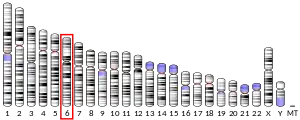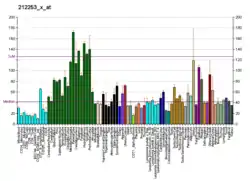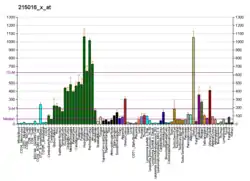Dystonin
Dystonin (DST), also known as bullous pemphigoid antigen 1 (BPAG1), isoforms 1/2/3/4/5/8, is a protein that in humans is encoded by the DST gene.[3][4][5]
This gene encodes a member of the plakin protein family of adhesion junction plaque proteins. Multiple alternatively spliced transcript variants encoding distinct isoforms have been found for this gene, but the full-length nature of some variants has not been defined. It has been known that some isoforms are expressed in neural and muscle tissue, anchoring neural intermediate filaments to the actin cytoskeleton, and some isoforms are expressed in epithelial tissue, anchoring keratin-containing intermediate filaments to hemidesmosomes. Consistent with the expression, mice defective for this gene show skin blistering and neurodegeneration.[5]
Interactions
Dystonin has been shown to interact with collagen, type XVII, alpha 1,[6][7] DCTN1[8] and erbin.[9]
See also
References
- GRCh38: Ensembl release 89: ENSG00000151914 - Ensembl, May 2017
- "Human PubMed Reference:". National Center for Biotechnology Information, U.S. National Library of Medicine.
- Stanley JR, Tanaka T, Mueller S, Klaus-Kovtun V, Roop D (January 1989). "Isolation of complementary DNA for bullous pemphigoid antigen by use of patients' autoantibodies". J Clin Invest. 82 (6): 1864–70. doi:10.1172/JCI113803. PMC 442765. PMID 2461961.
- Sawamura D, Nomura K, Sugita Y, Mattei MG, Chu ML, Knowlton R, Uitto J (March 1991). "Bullous pemphigoid antigen (BPAG1): cDNA cloning and mapping of the gene to the short arm of human chromosome 6". Genomics. 8 (4): 722–6. doi:10.1016/0888-7543(90)90261-R. PMID 2276744.
- "Entrez Gene: DST dystonin".
- Koster, January; Geerts Dirk; Favre Bertrand; Borradori Luca; Sonnenberg Arnoud (January 2003). "Analysis of the interactions between BP180, BP230, plectin and the integrin alpha6beta4 important for hemidesmosome assembly". J. Cell Sci. 116 (Pt 2): 387–99. doi:10.1242/jcs.00241. ISSN 0021-9533. PMID 12482924.
- Hopkinson, S B; Jones J C (January 2000). "The N terminus of the transmembrane protein BP180 interacts with the N-terminal domain of BP230, thereby mediating keratin cytoskeleton anchorage to the cell surface at the site of the hemidesmosome". Mol. Biol. Cell. 11 (1): 277–86. doi:10.1091/mbc.11.1.277. ISSN 1059-1524. PMC 14774. PMID 10637308.
- Liu, Jia-Jia; Ding Jianqing; Kowal Anthony S; Nardine Timothy; Allen Elizabeth; Delcroix Jean-Dominique; Wu Chengbiao; Mobley William; Fuchs Elaine; Yang Yanmin (October 2003). "BPAG1n4 is essential for retrograde axonal transport in sensory neurons". J. Cell Biol. 163 (2): 223–9. doi:10.1083/jcb.200306075. ISSN 0021-9525. PMC 2173519. PMID 14581450.
- Favre, B; Fontao L; Koster J; Shafaatian R; Jaunin F; Saurat J H; Sonnenberg A; Borradori L (August 2001). "The hemidesmosomal protein bullous pemphigoid antigen 1 and the integrin beta 4 subunit bind to ERBIN. Molecular cloning of multiple alternative splice variants of ERBIN and analysis of their tissue expression". J. Biol. Chem. 276 (35): 32427–36. doi:10.1074/jbc.M011005200. ISSN 0021-9258. PMID 11375975.
Further reading
- Nakajima D, Okazaki N, Yamakawa H, et al. (2003). "Construction of expression-ready cDNA clones for KIAA genes: manual curation of 330 KIAA cDNA clones". DNA Res. 9 (3): 99–106. doi:10.1093/dnares/9.3.99. PMID 12168954.
- Tanaka T, Parry DA, Klaus-Kovtun V, et al. (1991). "Comparison of molecularly cloned bullous pemphigoid antigen to desmoplakin I confirms that they define a new family of cell adhesion junction plaque proteins". J. Biol. Chem. 266 (19): 12555–9. PMID 1712022.
- Sawamura D, Li K, Chu ML, Uitto J (1991). "Human bullous pemphigoid antigen (BPAG1). Amino acid sequences deduced from cloned cDNAs predict biologically important peptide segments and protein domains". J. Biol. Chem. 266 (27): 17784–90. PMID 1717441.
- Sawamura D, Li KH, Nomura K, et al. (1991). "Bullous pemphigoid antigen: cDNA cloning, cellular expression, and evidence for polymorphism of the human gene". J. Invest. Dermatol. 96 (6): 908–15. doi:10.1111/1523-1747.ep12475433. PMID 2045679.
- Owaribe K, Kartenbeck J, Stumpp S, et al. (1991). "The hemidesmosomal plaque. I. Characterization of a major constituent protein as a differentiation marker for certain forms of epithelia". Differentiation. 45 (3): 207–20. doi:10.1111/j.1432-0436.1990.tb00475.x. PMID 2090522.
- Westgate GE, Weaver AC, Couchman JR (1985). "Bullous pemphigoid antigen localization suggests an intracellular association with hemidesmosomes". J. Invest. Dermatol. 84 (3): 218–24. doi:10.1111/1523-1747.ep12265229. PMID 2579167.
- Mutasim DF, Morrison LH, Takahashi Y, et al. (1989). "Definition of bullous pemphigoid antibody binding to intracellular and extracellular antigen associated with hemidesmosomes". J. Invest. Dermatol. 92 (2): 225–30. doi:10.1111/1523-1747.ep12276753. PMID 2645368.
- Mutasim DF, Takahashi Y, Labib RS, et al. (1985). "A pool of bullous pemphigoid antigen(s) is intracellular and associated with the basal cell cytoskeleton-hemidesmosome complex". J. Invest. Dermatol. 84 (1): 47–53. doi:10.1111/1523-1747.ep12274684. PMID 3880796.
- Nomura K, Sugawara T, Sato T, et al. (1995). "Expression of laminin, type IV procollagen and 230 kDa bullous pemphigoid antigen genes by keratinocytes and fibroblasts in culture: application of the polymerase chain reaction for detection of small amounts of messenger RNA". Arch. Dermatol. Res. 286 (7): 408–13. doi:10.1007/BF00371801. PMID 7818282. S2CID 33902783.
- Brown A, Lemieux N, Rossant J, Kothary R (1994). "Human homolog of a mouse sequence from the dystonia musculorum locus is on chromosome 6p12". Mamm. Genome. 5 (7): 434–7. doi:10.1007/BF00357004. PMID 7919656. S2CID 324880.
- Hopkinson SB, Jones JC (1994). "Identification of a second protein product of the gene encoding a human epidermal autoantigen". Biochem. J. 300 (3): 851–7. doi:10.1042/bj3000851. PMC 1138243. PMID 8010969.
- Elgart GW, Stanley JR (1993). "Cloning of the 5' mRNA for the 230-kD bullous pemphigoid antigen by rapid amplification of cDNA ends". J. Invest. Dermatol. 101 (2): 244–6. doi:10.1111/1523-1747.ep12365083. PMID 8345227.
- Tamai K, Sawamura D, Do HC, et al. (1993). "The human 230-kD bullous pemphigoid antigen gene (BPAG1). Exon-intron organization and identification of regulatory tissue specific elements in the promoter region". J. Clin. Invest. 92 (2): 814–22. doi:10.1172/JCI116655. PMC 294919. PMID 8349819.
- Brown A, Dalpé G, Mathieu M, Kothary R (1996). "Cloning and characterization of the neural isoforms of human dystonin". Genomics. 29 (3): 777–80. doi:10.1006/geno.1995.9936. PMID 8575775.
- Tang HY, Chaffotte AF, Thacher SM (1996). "Structural analysis of the predicted coiled-coil rod domain of the cytoplasmic bullous pemphigoid antigen (BPAG1). Empirical localization of the N-terminal globular domain-rod boundary". J. Biol. Chem. 271 (16): 9716–22. doi:10.1074/jbc.271.16.9716. PMID 8621649.
- Bonaldo MF, Lennon G, Soares MB (1997). "Normalization and subtraction: two approaches to facilitate gene discovery". Genome Res. 6 (9): 791–806. doi:10.1101/gr.6.9.791. PMID 8889548.
- Hillier LD, Lennon G, Becker M, et al. (1997). "Generation and analysis of 280,000 human expressed sequence tags". Genome Res. 6 (9): 807–28. doi:10.1101/gr.6.9.807. PMID 8889549.
- Nagase T, Ishikawa K, Suyama M, et al. (1999). "Prediction of the coding sequences of unidentified human genes. XI. The complete sequences of 100 new cDNA clones from brain which code for large proteins in vitro". DNA Res. 5 (5): 277–86. doi:10.1093/dnares/5.5.277. PMID 9872452.






